Nylabones have entertained countless canines over the years, but with owners starting to look more at chew safety, many wonder how safe they really are.
Below, we’ll dive in deep on Nylabones and help you determine if they’re the best chew for your dog.
Key Takeaways: Are Nylabones Safe for Dogs?
- Nylabones have been around for over 66 years and many dogs have enjoyed them without issue. On the other hand, some dogs have suffered injuries (or worse) after chomping on these nylon-based chew toys.
- Ultimately, Nylabones are safer than some chews but more dangerous than others. Every chew has inherent risks, including Nylabones, but with proper precautions, most dogs gnaw them without issue.
- Chew safety basics will help keep your canine happy and healthy. Prevent injury and heartbreak by selecting the right chew for your dog and monitoring him when he has a chew or other toy.
What Is a Nylabone?
A long-loved brand in the dog world, Nylabone got its start in 1955. The company makes non-edible and edible lines of dog chews, with the non-edible chews made from plastic, rubber, or nylon — the flagship material that influenced the brand’s moniker.
The standard Nylabone is a brown, bone-shaped toy that’s designed to be chewed but not consumed.
However, Nylabone offers more than the standard tan bone many owners are familiar with. They also offer chews of several durability levels, sizes, flavors, colors, and shapes. The brand has something for seemingly every dog, but pay close attention to each line’s features to find the best chew for your pup.
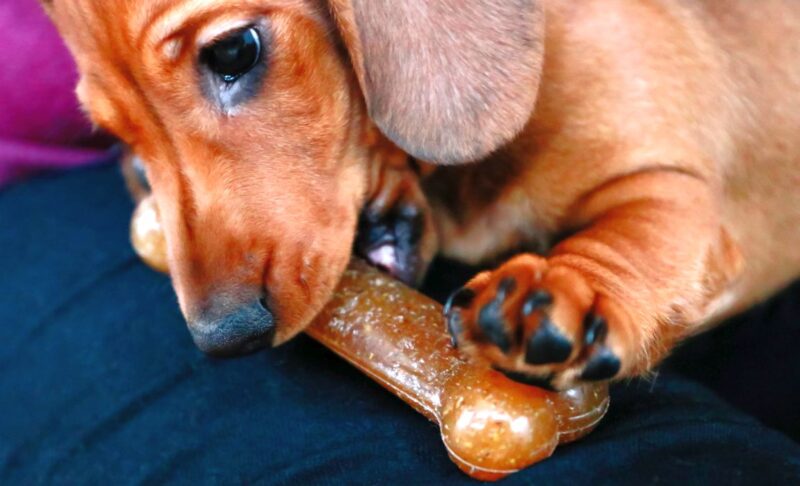
Nylabone Durability Levels
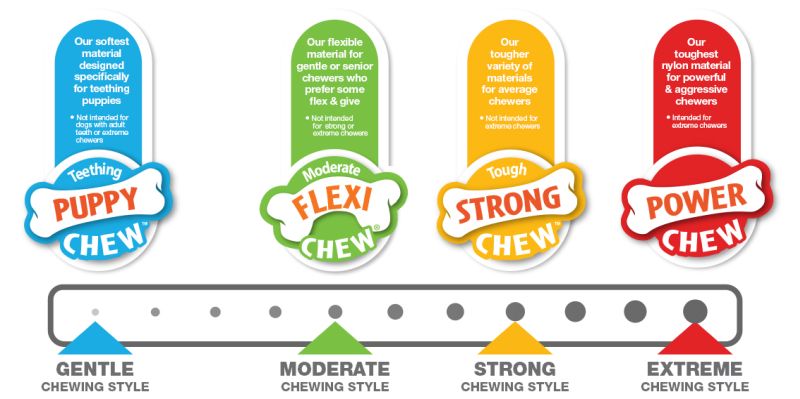
Nylabone offers different chew strengths for their products, including:
- Teething Puppy Chew: As the softest line, these are intended for teething puppies with delicate (but sharp!) chompers. These are especially valuable, as puppies don’t yet know their bite strength and can accidentally damage their teeth by chomping down on super-hard chews.
- Moderate Flexi Chew: Made with a flexible material, this line is designed for gentle chewers and seniors who still love to chew but are at a greater risk of tooth damage. This line is not durable enough for regular or aggressive chewers.
- Tough Strong Chew: Hard and durable, this line is intended for average chewers. Most dogs likely would fall into this category, but as always, use your best judgement. This level is too hard for puppies and seniors but still too delicate for heavy-duty chewers.
- Power Chew: Best for aggressive chewers, this line is made of sturdy nylon that can stand up to powerful jaws. These products aren’t intended for puppies or gentle chewers.
Selecting the right chew strength is crucial in preventing tooth damage. Always refer to the Nylabone chew style guide to find the best chew strength for your dog.
Nylabone Sizes

With products for every breed from Chihuahuas to mastiffs, Nylabone is a one-stop-shop company for great chews for any size dog, offering sizes:
- Puppy
- X-Small
- Small
- Medium
- Large
- X-Large
- Monster
Finding the right size chew is critical for safety, with X-Small being the perfect pick for toy breeds like Yorkies and Maltese, while Monster is the best size for Great Danes and other giant breeds.
Nylabone Flavors
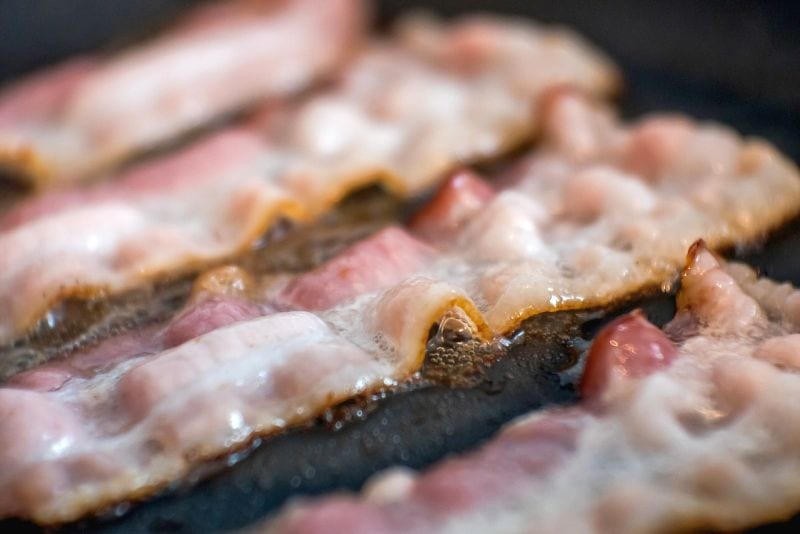
Perfect for tempting finicky Fidos, Nylabone chews come in a number of flavors, like:
- Original
- Bacon
- Chicken
- Beef
- Bison
- Cheeseburger
- Peanut butter
Some dogs may prefer the mild chicken-based taste of the original flavoring, while others may need something stronger, like bacon. Flavoring helps direct your dog to chew the Nylabone instead of your stuff, a must if you have a puppy at home.
Nylabone Shapes
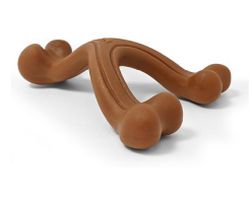
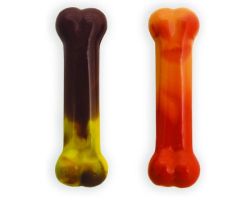
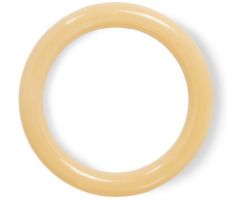
One of Nylabone’s biggest advantages over their competition is the wide array of shapes their chews are offered in, including:
- Traditional bone
- Teething ring
- Circle
- Jack
- Barbell
- Animal
Some shapes are better than others, with the bone-shaped chews working for most dogs. Meanwhile, teething rings are smaller, making them better-suited for puppies and small dogs.
Keep your dog’s chewing style in mind here, as knobbed ends can be chewed off and swallowed if you’re not careful.
Nylabone Colors
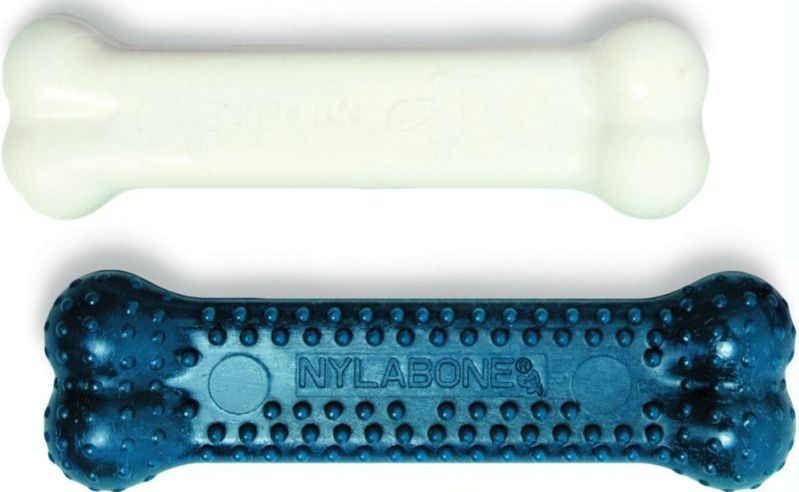
Nylabone offers a rainbow of colors to choose from for many of their products, like:
- Pink
- Blue
- Yellow
- Natural beige
- Red
- Brown
Color typically isn’t a make-or-break aspect for pup owners, but it’s good to know what you’re getting before purchase, so keep an eye out for color selection boxes.
Benefits and Drawbacks of Nylabones
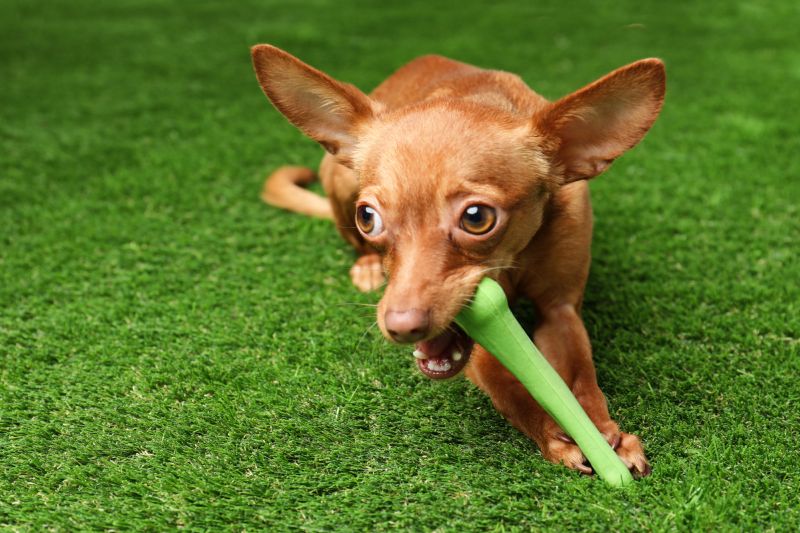
As with any chew, Nylabones come with a share of pros and cons to consider. While the chews may work well with some dogs, they might be the exact opposite of what your dog needs based on his chewing style.
The Benefits of Nylabones
It’s no coincidence that Nylabones have been around for decades. Pup parents and doggos alike can’t get enough of them for several reasons, including:
- They offer an appropriate outlet for chewing instincts. Dogs need to chew. It’s hardwired in your pup’s DNA and is a critical piece of canine enrichment. Chews like Nylabones offer a way to exercise this behavior without damaging your furniture or shoes.
- Nylabones help curb boredom and anxiety. Chews like Nylabones keep your fur kiddo occupied, putting his brain and body to use (and preventing him from finding destructive fun around the house.) If you have a chomp-happy puppy, a Nylabone can be a finger and toe saver!
- They’re affordably priced. Starting around $2 a chew, Nylabones aren’t going to blow a hole in your budget. Longer lasting than bully sticks, they also tend to last a while at that price, giving you better bang for your buck.
- Nylabones are long-lasting dog chews. Nylabones are some of the best dog chews for aggressive chewers. Made with durable nylon, they can last for days, months, or even years in some (relatively rare) cases.
- Nylabones may provide dental benefits. Chewing helps remove plaque and tartar from your dog’s teeth, so just nomming on a Nylabone will help promote dental health. Some Nylabone products also feature a textured surface that further helps wear away buildup in hard-to-reach places along the gumline.
- Nylabones are just tasty! Nylabone’s flavor coating options make them more enticing than non-flavored chews, like rope toys.
The Drawbacks of Nylabones
While Nylabones are certainly a top-seller with many benefits, they do come with a list of possible problems to look out for, like:
- They are too hard for some dogs. Nylabone products are incredibly hard, with several not passing the “fingernail test” (meaning that you can’t dent them with your fingernail). This makes some owners and vets uncomfortable with their tooth safety profile due to their potential to fracture a dog’s teeth.
- Classic Nylabones are not digestible. Not all Nylabone items are meant for ingestion, and if your pup swallows a hunk, his body can’t break it down, potentially risking bowel obstruction or backdoor damage if the piece is large or jagged.
- They may become contaminated with bacteria. As with any chew, Nylabones can harbor bacteria. So, always clean them between chew sessions to keep your pup safe.
- Nylabones are not natural. No matter how you slice it, natural chews (that are soft enough for routine chewing) beat out artificial ones any day. Nylabone’s non-edible chews may contain plastic, rubber, or nylon and they aren’t intended for ingestion.
- Nylabones are made in multiple manufacturing locations. Many Nylabone products are made in the USA, but some are unfortunately manufactured in China. Always check for the made-in-the-USA dog toy emblem on the packaging to be sure.
- Nylabones present a splintering risk. Nylon chews can crack and splinter, risking mouth damage or intestinal harm if swallowed.
Nylabones are a bit tricky. They’re made of plastic and not made to be ingested and yet…dogs usually end up ingesting some (or even a lot) of these chews. I give my own dog Remy Nylabones because I feel the risks outweigh the rewards. Chewing is a calming, naturally soothing activity for dogs, and Remy loves chewing.
I’ve observed Remy chewing Nylabones before and he seems to spit out a good portion of the material as he chews it. While he chomps pretty hard, I’ve never seen him really bite down relentlessly hard with his back teeth – he mostly nibbles and picks at the chew with his front teeth.
On top of that, I’ve taken him to the vet several times and I’ve never gotten warnings about his teeth or any fractures, so we’ll be continuing to incorporate Nylabones as part of our routine.
Even if your dog seems to be able to enjoy Nylabone safely, never leave your dog with one alone. Just recently I gave Remy a new kind of nylon-style chew that was slightly softer than what he normally gets. I noticed him chewing through it very quickly, and took it away. The next day Remy threw up twice, with bits of plastic in his regurgitation. Clearly this chew was a bad fit for him, so I tossed it.
Ultimately, I’d recommend observing your dog with a Nylabone to assess his chew style. You could even send a clip to your vet to confirm if your dog is enjoying the Nylabone safely or not. If your dog is eating a lot of the chew or pressing down extremely hard with his back teeth, a softer, consumable chew might be better. (Meg Marrs, Founder of K9 of Mine)
Bottom Line: Are Nylabones Safe for Dogs?
Nylabone offers a diverse range of products, with some posing greater risks than others. But overall, Nylabones can be just as safe as any other hard chew toy.
However, practical safety steps are a must to keep your canine chewing away without suffering an injury or illness.
For the safest chewing experience, always:
- Select the appropriate size chew. To avoid choking or ingestion, make sure a bone isn’t small enough to fit entirely in your dog’s mouth. At the same time, you want a Nylabone that’s not so large that your pup can’t chew it properly, risking damage to canine teeth.
- Pick the correct durability level. Keep your dog’s chew habits in mind while browsing Nylabones. Chews that are too hard can damage your dog’s teeth, while those that are too soft can break down quickly and allow your dog to swallow them. This is especially important for puppies, who are more liable to break their teeth on stronger adult-designed chews as opposed to the softer, more gentle puppy versions.
- Monitor your pup while he’s chewing. Always watch your dog when he has a toy or chew. We know it’s hard, especially if he likes to run off to his bed with his toys, but accidents happen, and you want to be there just in case he chokes. Trust us; you’d rather be there for a thousand nothings than not be there for one choking incident.
- Assess your dog’s chew style. In addition to monitoring your dog to assess for choking risks, you’ll also want to carfully observe how your dog chews on the Nylabone. Is he pressing down hard with his back teeth? Or is he chewing a bit, adjusting, and picking at the chew? Is he consuming the plastic, or spitting it out? If your dog seems to be practicing safe chewing behavior with the Nylabone, you can feel better about trusting him with one (but as always, you’ll never want to leave him with one unattended).
- Inspect the chew before every chew session. Examine your dog’s chew for sharp edges and loose bits to prevent mouth injuries or ingestion. You also want to make sure the bone hasn’t become too small.
- Replace the chew as needed. Don’t let your dog keep a Nylabone he’s gnawed into a sharp point or small nub. Mouth injuries and intestinal obstructions aren’t fun (or cheap to treat!)
- Clean the chew regularly. To avoid bacterial growth, give your pup’s Nylabone a good cleaning after each use with water and mild soap. Not only does this prevent noxious odors, but it protects your dog from getting sick. Never place any Nylabone product in the dishwasher.
- Store your dog’s chew properly. Keep your dog’s chews in a clean, dry environment to prevent mold or bacterial growth. Avoid extreme temperatures that may cause melting or fracturing, compromising the chew’s structure. Some Nylabone products are meant to be frozen but always refer to the product’s packaging for instructions.
Remember: Contact your veterinarian immediately if your dog suffers an injury or swallows a Nylabone piece larger than a grain of rice.
This is a sponsored placement, in which an advertiser pays a fee to be featured in this article. Learn more
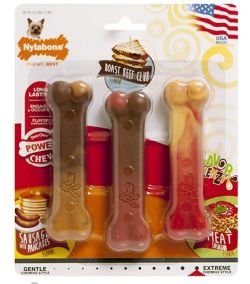
Nylabone Flavor Frenzy Power Chew Triple Pack
Nylon, bone-shaped dog chews flavored in three different pooch-pleasing ways.
Nylabone Healthy Edibles: A Potential Alternative
If you’re not keen on inedible Nylabones, and you want some kind of chew your dog can actually eat, the brand has another product you might like instead: Nylabone Healthy Edibles.
This is a sponsored placement, in which an advertiser pays a fee to be featured in this article. Learn more
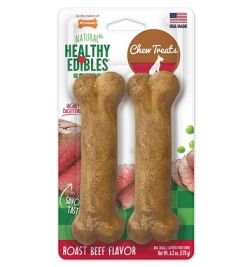
Nylabone Healthy Edibles Twin Pack
An alternative to traditional Nylabones, these chews are designed to be consumed.
Made in the USA with natural ingredients and no plastics, your four-footer can gnaw away to his heart’s content. The flavor and texture can be more enticing to pickier pups, but this line isn’t as durable as Nylabone’s other offerings. If you have a dog with dietary sensitivities, keep an eye on the ingredient list as well.
Don’t Confuse Nylabones with Benebones
While somewhat similar in materials and name, Benebones aren’t the same as Nylabones. They are nylon-based like the original Nylabone line, so they’re also non-edible, but they differ in a few areas that may make them a better or worse fit for your four-footer.
This is a sponsored placement, in which an advertiser pays a fee to be featured in this article. Learn more
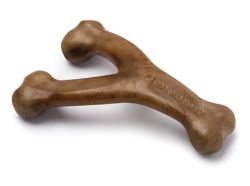
Benebone Wishbone Dog Chew
US-made flavored nylon dog chews that are available in several shapes and sizes.
Pros
- Benebones are made in the USA using USA-sourced nylon and flavorings only.
- The brand offers several flavorings, including bacon, chicken, peanut butter, jack salmon, and maple wood.
- Benebones come in five sizes to cover all dog breeds: tiny, small, medium, large, and giant.
- As with Nylabone, the nylon material is long-lasting.
- The brand’s puppy line features a soft construction made specifically for teething teefers.
- Benebones are made in six styles, including a fishbone, stick, and wishbone design, and only come in tan and brown, depending on flavor.
Cons
- Most Benebone products do not pass the fingernail test, making them potentially dangerous. This hardness increases your dog’s risk of tooth injuries, and they shouldn’t be offered to pups with weak teeth.
- Benebones are generally more expensive than Nylabones.
- Because they’re made of nylon (same as Nylabones), Benebones do come with a risk of splintering, causing mouth injuries or intestinal damage if swallowed.
Both of these dog chews are pretty similar, but the key differences include:
- Benebones are only made in the USA; some Nylabones are made in China.
- The Nylabone product line is more extensive, giving you more options in terms of shape, size, flavor, and color.
- Benebones are usually a bit more expensive than Nylabones.
General Dog Chew Safety with Nylabones (and All Chews)
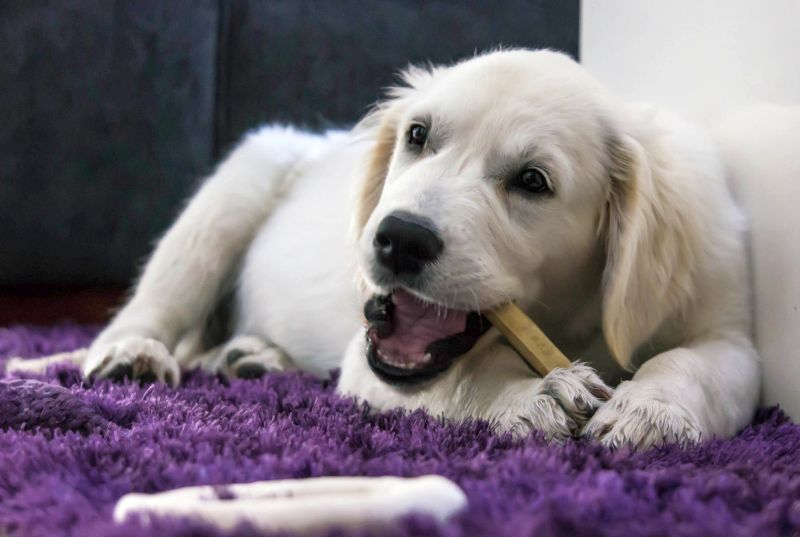
While chewing is a fun, natural behavior your dog should be allowed to express, it’s important to keep safety front and center to avoid accidental injuries. Mouth and tooth injuries are immediately painful and sometimes tricky to treat, while intestinal blockages are not only painful but potentially deadly.
To keep chewing safe and fun:
- Always monitor your dog when he has a chew: All it takes is one second, and your dog could swallow a chew and choke or risk a blockage. While you’re at it, brush up on your canine Heimlich skills to stay prepared.
- Only select chews that pass the fingernail test: If you can’t leave a mark in a chew when you press your fingernail into it, it’s too hard for your pup and risks damaging his teeth.
- Size accordingly: Prevent your dog from choking and swallowing his chew by selecting one your dog can’t fit entirely in his mouth.
- Look for VOHC approval: Products approved by the Veterinary Oral Health Council are found to reduce plaque and tartar in your dog’s mouth.
- Clean all chews regularly: Bacterial buildup isn’t just a risk to your dog; it’s dangerous for you too. Always wash a chew regularly to prevent germs from lingering. In most cases, this means cleaning it with soap and water, but refer to care instructions just in case.
***
Does your dog enjoy Nylabones? Does he have another chew he can’t get enough of? Let us know in the comments!
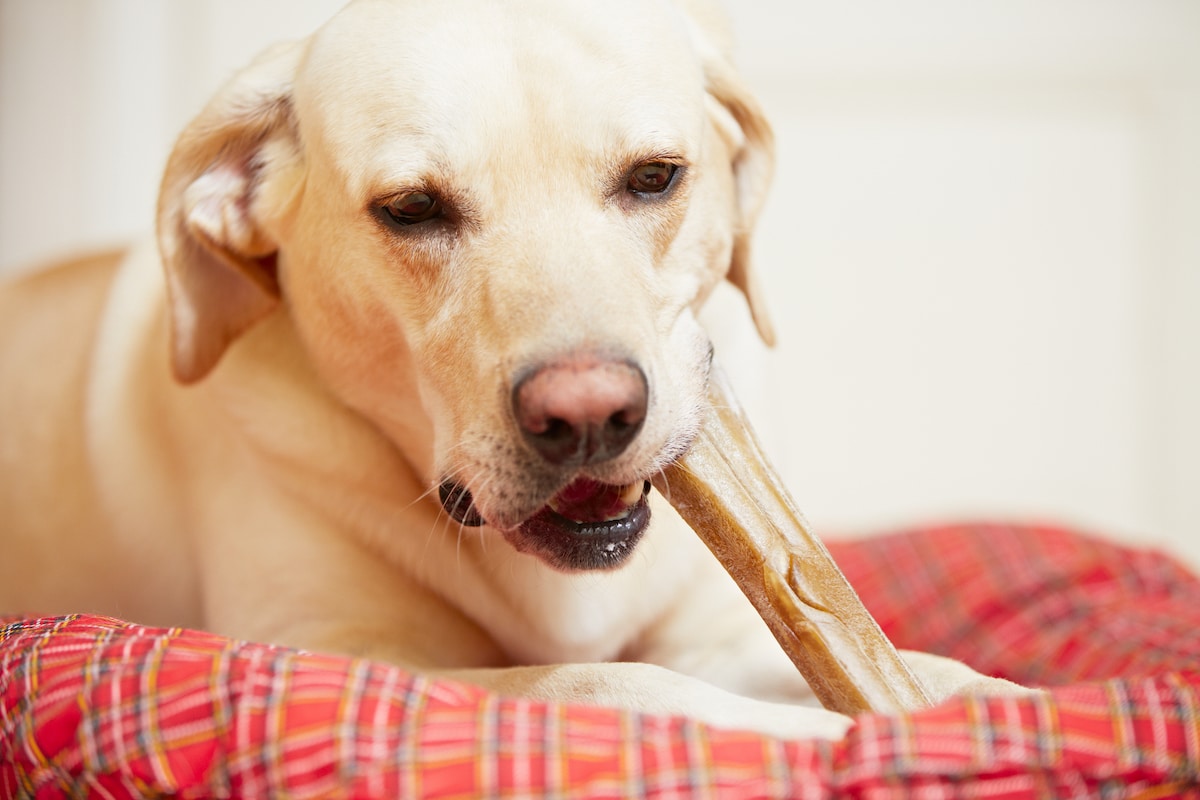

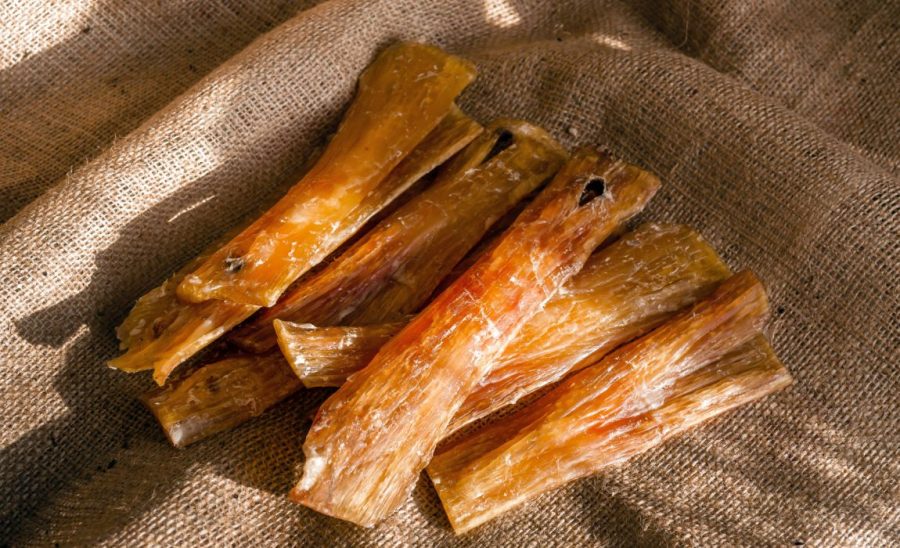


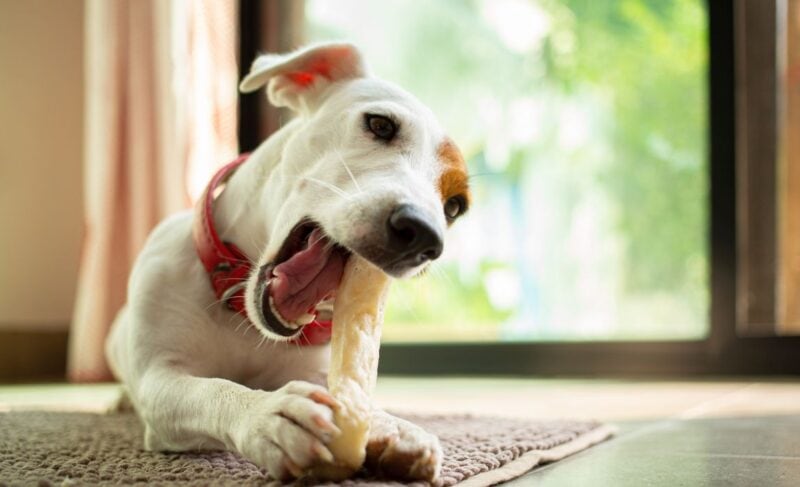
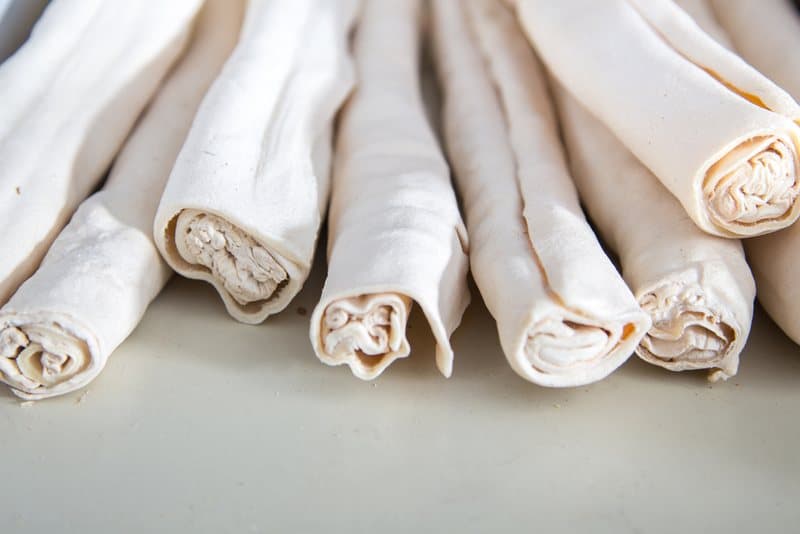
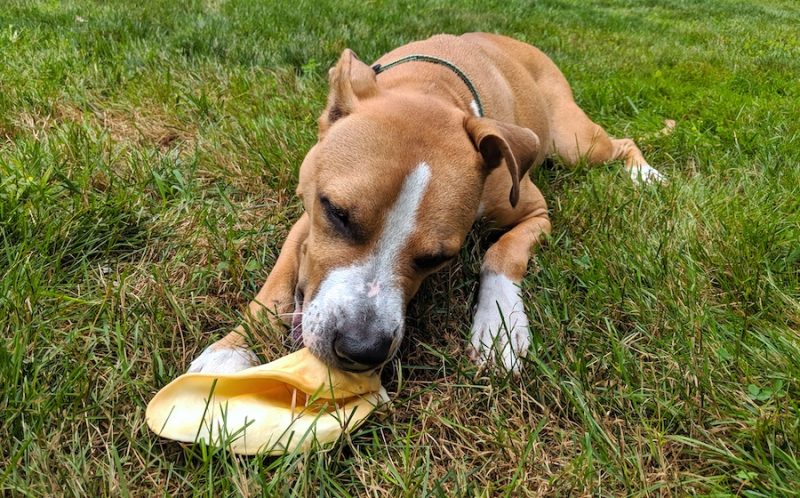

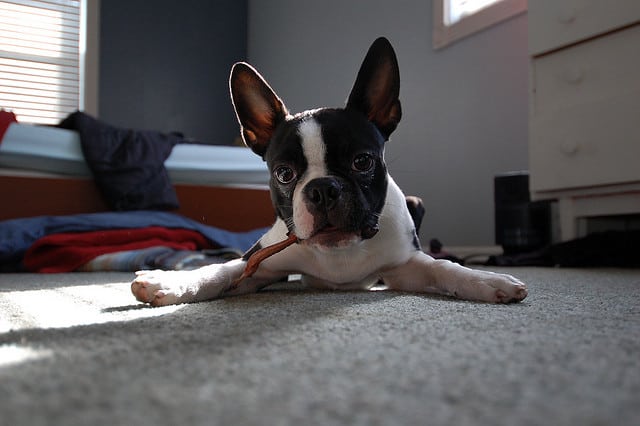
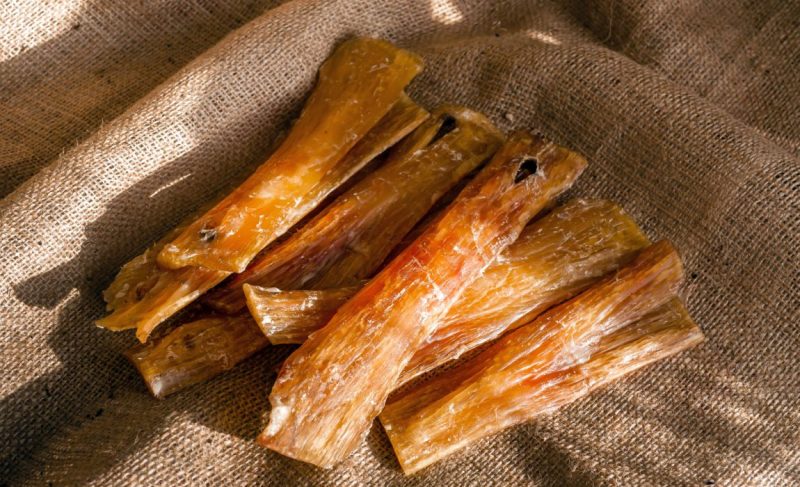
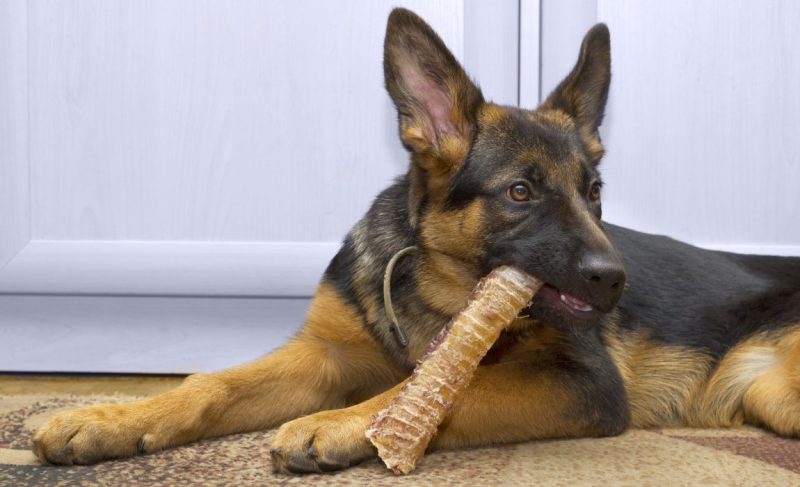

Leave a Comment